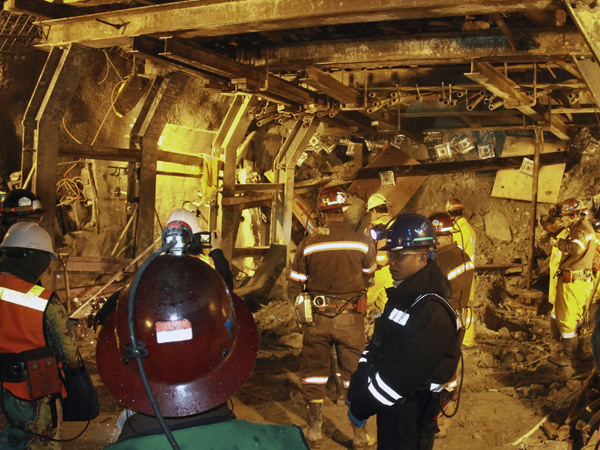More bodies recovered in collapsed Indonesia mine

In this photo released by PT Freeport Indonesia, the Indonesian unit of Arizona-based Freeport-McMoRan Copper & Gold Inc, rescuers gather inside a tunnel that collapsed on Tuesday morning as they continue the attempt to rescue trapped workers at Big Gossan mining area in Mimika, Papua province, Indonesia, Sunday, May 19, 2013. AP Photo/PT Freeport Indonesia
TIMIKA, Indonesia — Rescuers recovered four more bodies from a collapsed underground room at a giant US-owned gold and copper mine in Indonesia, bringing the confirmed death toll to 13, police said Monday. Fifteen other workers were still missing and feared dead.
The Big Gossan underground training facility at the PT Freeport Indonesia mine collapsed last Tuesday when 38 workers were undergoing safety training. Ten injured miners were rescued.
Mining operations at the Grasberg mine in the easternmost province of Papua have been suspended since the accident to pay respects to the victims and to concentrate on the rescue effort. The company said the accident was expected to have no significant impact on its operations.
Papua police spokesman Lieutenant Colonel Gede Sumerta Jaya said four more bodies were found early Monday buried under tons of rocks and dirt. They include one woman, added Sumerta.
“There is no possibility of life five days after the cave-in … this is really a heartbreaking accident,” he said.
Article continues after this advertisementThe company said in a statement that rescuers were trying to recover six more bodies seen in the rubble but the process was being slowed by the need to stabilize the ground and roof because of falling rocks.
Article continues after this advertisementIt said Richard Adkerson, president and CEO of its parent company, Freeport McMoran Copper and Gold Inc., arrived at the scene Saturday and visited the injured workers and the families of those still buried at the accident site.
Around 1,000 workers were still blocking a main road about two miles (three kilometers) away in solidarity with the victims, and to seek a guarantee of worker safety underground.
Indonesian President Susilo Bambang Yudhoyono has ordered Freeport and government agencies to thoroughly investigate the accident.
More than 20,000 workers are employed at the mine that has repeatedly been targeted by arson attacks, roadside bombs and blockades since production began in the 1970s. It’s located in the remote mountains of Papua province, which is home to a decades-long, low-level insurgency.